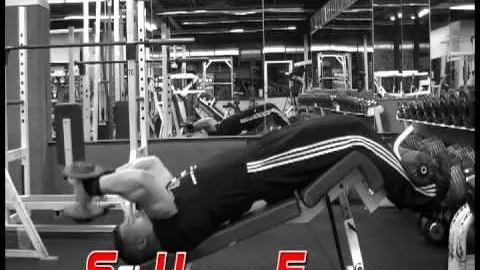
If you're looking to enhance your upper body strength and develop a strong and muscular physique, then the decline dumbbell pullover is an exercise you should definitely consider. This compound movement primarily targets your chest and back muscles, while also engaging your shoulders, triceps, and core. In this guide, we will provide you with a step-by-step breakdown of the decline dumbbell pullover, including proper form, variations, and benefits.
The decline dumbbell pullover is an effective exercise that stimulates multiple muscle groups simultaneously. This exercise can be particularly beneficial for the following reasons:
Targeted Muscle Engagement: The decline position focuses the tension on your chest and back muscles, facilitating their development and providing a greater range of motion compared to other variations of the pullover.
Increased Chest Expansion: The decline angle helps maximize chest expansion during the movement, making it an excellent exercise for enhancing your pectoral muscles.
Improved Posture and Stability: As you perform the decline dumbbell pullover, your core muscles, including your abs and lower back, are engaged to maintain a stable position. Regularly practicing this exercise can lead to improved posture and stability.
Improved Shoulder Mobility: The decline dumbbell pullover requires a controlled and extensive range of motion for the shoulder joint, helping to improve overall shoulder mobility and flexibility.
Compound Movement: As a compound exercise, the decline dumbbell pullover recruits multiple muscle groups simultaneously, leading to increased calorie expenditure and potential fat loss.
Follow these step-by-step instructions to ensure proper form and get the most out of your decline dumbbell pullover exercise:
Set up a decline bench at an angle of approximately 30-45 degrees. Lie down on the bench, your head towards the lower end, and your feet secured for stability.
Hold a dumbbell with both hands, gripping it firmly in an overhand grip. Position the dumbbell above your chest, with your arms fully extended.
Inhale deeply and lower the dumbbell slowly behind your head, maintaining a slight bend in your elbows to protect your joints. Focus on feeling the stretch in your chest while keeping your core engaged.
Exhale, and raise the dumbbell back to the starting position, using your chest and back muscles to drive the movement. Keep your elbows slightly bent throughout the movement, avoiding excessive strain on your joints.
Repeat for the desired number of repetitions, ensuring a controlled and smooth motion throughout.
To keep your workouts challenging and prevent plateaus, consider incorporating these variations of the decline dumbbell pullover into your routine:
Single-Arm Decline Dumbbell Pullover: Instead of using both arms, perform the exercise with only one dumbbell at a time, alternating between each arm. This variation places more emphasis on balance and stability while intensifying the engagement of your core muscles.
Decline Dumbbell Pullover with a Twist: At the top of the movement, instead of returning directly to the starting position, rotate your torso towards one side before lowering the dumbbell back behind your head. Alternate the side of the twist with each repetition to target your obliques and engage more muscles.
Decline Barbell Pullover: Instead of using dumbbells, perform the pullover exercise with a barbell. This variation allows you to handle heavier weights, but it also requires more stability and coordination.
To ensure your safety and prevent injuries during the decline dumbbell pullover, keep the following tips in mind:
The decline dumbbell pullover is a highly beneficial exercise for targeting your chest, back, and other major muscle groups. By incorporating this compound movement into your workout routine, you can improve muscle strength, enhance posture and stability, and develop a well-rounded upper body physique. Remember to always prioritize safety and proper form to maximize the effectiveness of this exercise. Start slow, progress gradually, and enjoy the many benefits the decline dumbbell pullover has to offer.
If you're looking for a gym, fitness club or yoga studio, you've come to the right place.
You can find information about gyms in your area. Browse catalog of gyms and find gyms with classes which are you looking for.
On gym page you can find simple information like address, phone or website. You can find list of available classes. You can check availability of personal training or small group classes. On place page you can also see information about open hours.
You can find gyms near you with amenities, courts, studios and equipments.
Use our map to find gym at your city or district.
In Gym Navigator you can find list of exercises with movies for many body parts.
You can browse exercises catalog and find exercises the best of you.
You can also find exercises grouped into workout plans, which you can use to improve you body. Each routine show you exercises one by one and give you possibility to count you progress and count down rest time.